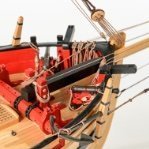-
Posts
4,112 -
Joined
-
Last visited
Content Type
Profiles
Forums
Gallery
Events
Everything posted by glbarlow
-
I've had the wood kit for this cross section for years, just never motivated to start it. I'm sure following your log will motivate me to look at it again. I did manage not to break into the lovely boxwood that I have for some other project so it must stay on my mind some. The practice runs on the keel are a really good plan, taking it slow to get it right.
-
Can these be done really fast and without removing the char 😂🤣😂🤣
- 1,784 replies
-
- winchelsea
- Syren Ship Model Company
-
(and 1 more)
Tagged with:
-
Congratulations on completing Cheerful. It’s a wonderful model to build and you’ve done a very nice job of it.
- 274 replies
-
- Cheerful
- Syren Ship Model Company
-
(and 1 more)
Tagged with:
-
I agree with Chuck and James. Removing all the char from pieces before assembly is not an advanced skill. That alone makes a big difference and should jump past any “good enough” qualifier. Chuck’s initial comments aren’t to belittle, but to encourage taking a little more time to get a lot better result. At least that’s how I read it.
-
The level of detail, accuracy, and outright wow factor is what excites me about this project. I think others may gush over those other designs because they themselves are major steps above older kits and designs and a lot for a basic, anyone can assemble, kit. As appealing as they might be they are not in that same league, not even close, as to what you’re doing for us with Winnie. You make the deal for us by providing your advanced designs in way we mere mortals can still build them. Please don’t cut corners to make it simpler unless it's a simpler way to achieve an advanced design. This is why Winchelsea stands alone.
- 1,784 replies
-
- winchelsea
- Syren Ship Model Company
-
(and 1 more)
Tagged with:
-
Don’t give up on the square tuck, it’s a signature item. Your planking looks great.
- 112 replies
-
- Cheerful
- Syren Ship Model Company
-
(and 1 more)
Tagged with:
-
I’m glad this works for you but not how I would recommend.
- 857 replies
-
- Sphinx
- Vanguard Models
-
(and 1 more)
Tagged with:
-
I applied only black Strylex primer with the airbrush then weathered them. I’m sure the fixative is a good alternate approach. You do have to do something, I don’t think applying it directly to the resin would work well. When I build Winnie’s stove I’ll apply Dull Coat after the weathering powder as Chuck did. I saw no need for it on either Cheerful or Flirt’s guns. So far both look fine.
- 857 replies
-
- Sphinx
- Vanguard Models
-
(and 1 more)
Tagged with:
-
Looks great, congrats on almost being done!
- 274 replies
-
- Cheerful
- Syren Ship Model Company
-
(and 1 more)
Tagged with:
-

Focus Stacking
glbarlow replied to Dennis P Finegan's topic in Photographing your work. How to do this.
No offense taken. I also didn’t mean to offend anyone pointing out while a rail is likely helpful in a macro environment especially if your doing the focusing steps manually, it isn’t helpful for focus stacking in a landscape environment and isn’t needed at all with Nikon’s Focus Shift feature, However in the agree to disagree column I can easily demonstrate image quality differences In multiple categories between a kit or low end lens and a high end one. The difference between cameras is mostly measured in features and control but there are quality differences there too. Ship building and photography are both my hobbies, but photography pays me back in image sales on occasion. Acknowledging I’m being a bit critical, the street photo posted isn’t in focus at all, front to back. Any image shot at a small aperture at a far enough distance can be in focus, but that’s hardly the point in discussing this method for ship models. Like you, mine is only an opinion formed from experience. -
Perfect, this is great stuff.
- 1,784 replies
-
- winchelsea
- Syren Ship Model Company
-
(and 1 more)
Tagged with:
About us
Modelshipworld - Advancing Ship Modeling through Research
SSL Secured
Your security is important for us so this Website is SSL-Secured
NRG Mailing Address
Nautical Research Guild
237 South Lincoln Street
Westmont IL, 60559-1917
Model Ship World ® and the MSW logo are Registered Trademarks, and belong to the Nautical Research Guild (United States Patent and Trademark Office: No. 6,929,264 & No. 6,929,274, registered Dec. 20, 2022)
Helpful Links
About the NRG
If you enjoy building ship models that are historically accurate as well as beautiful, then The Nautical Research Guild (NRG) is just right for you.
The Guild is a non-profit educational organization whose mission is to “Advance Ship Modeling Through Research”. We provide support to our members in their efforts to raise the quality of their model ships.
The Nautical Research Guild has published our world-renowned quarterly magazine, The Nautical Research Journal, since 1955. The pages of the Journal are full of articles by accomplished ship modelers who show you how they create those exquisite details on their models, and by maritime historians who show you the correct details to build. The Journal is available in both print and digital editions. Go to the NRG web site (www.thenrg.org) to download a complimentary digital copy of the Journal. The NRG also publishes plan sets, books and compilations of back issues of the Journal and the former Ships in Scale and Model Ship Builder magazines.




